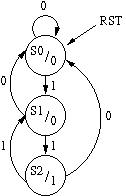
ECED 4260 IC Design and Fabrication
OBJECTIVES
To get familiar with RTL Implementation, Structural and Behavioral coding of VHDL. At the register-transfer (RT) level, the basic building blocks are modules constructed from simple gates. They include functional units, such as adders and comparators, storage components, such as registers, and data routing components, such as multiplexers.
A 2 to 1 multiplexer has two inputs (a) and (b) as well as a select signal (sel). The truth tables for the operation of a multiplexer is given:
|
|
| ||||
|
|
|
|
|
|
|
|
|
|
|
|
| |
|
|
0 |
|
|
| |
For this part of the lab, you will structurally build and test a 4-input MUX using the RTL description of a 2-input MUX as a base component. Use this MUX_4 to start and save it as "MUX_4.vhd".
Build and test a design for a three state Moore machine. The Moore machine is built to detect an non overlapping pattern of "11" with an asynchronous reset. State machines are built using behavioral VHDL. The state diagram for the pattern detector is provided.

Part of the VHDL code is given for the pattern detector ( There are couple errors, you have to fix them to pass the compilation) :
entity PatternDetector is architecture behavioral of PatternDetector is -- Declare a
new type for the states and declare begin -- Create a
process that handles the state transition
when S1 =>
when S2 => -- Define
the outputs based on what state the machine is in. end behavioral;
|
Last Updated: September 16, 2024